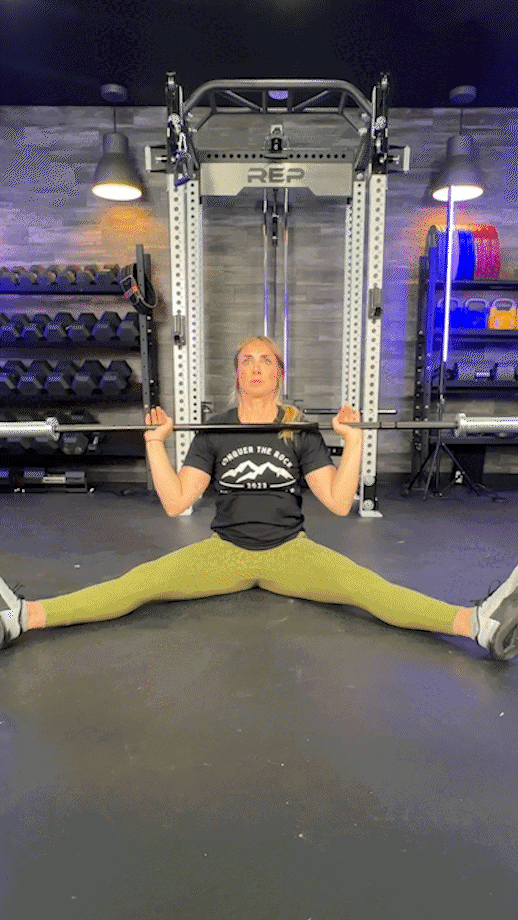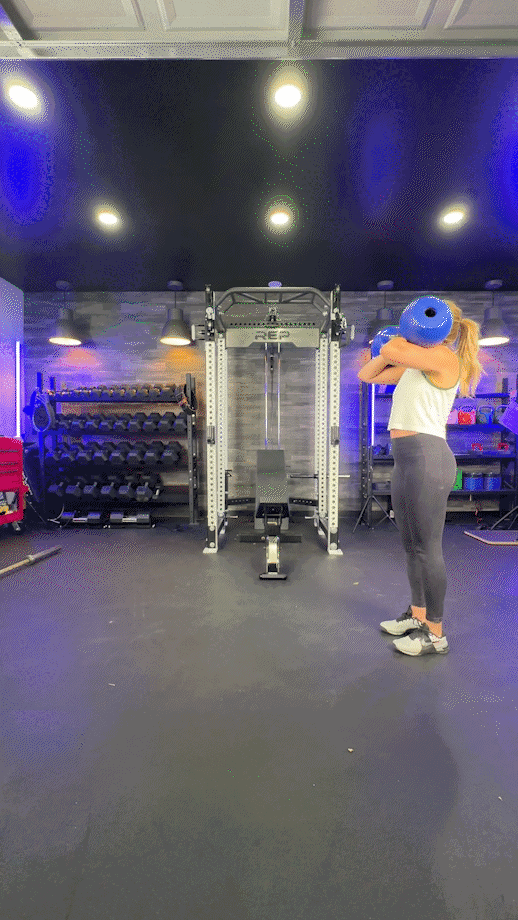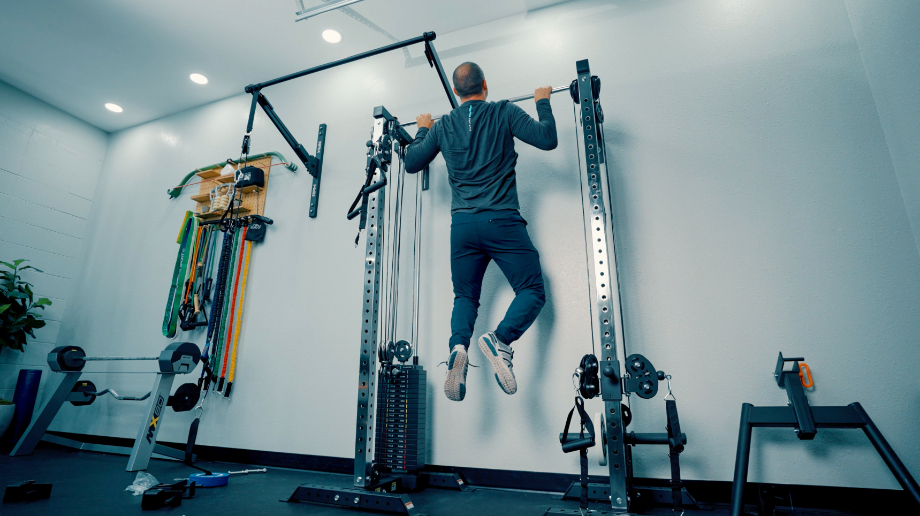Developed by famed strongman Žydrūnas Savickas, the Z Press exercise is a highly effective yet underutilized overhead press variation that minimizes lower-body muscle recruitment while providing optimal muscle activation to the upper body.
“It’s also an ideal lift for learning proper scapular control, which is important for reducing your risk of injury on overhead lifts,” says Caine Wilkes, OLY, USAW-L1, and GGR senior staff writer.
If you’re ready to add this peculiar but powerful upper-body movement to your training arsenal, sit down and stay awhile. We’ll cover everything you need to know about this press from A to Z, including a step-by-step tutorial for mastering the proper form. Check it out below!
How To Do the Z Press
Performing the overhead press from a standing position may activate your upper and lower-body muscles; however, taking a seat on the floor for the Z press will reduce your lower-body engagement, increasing activation in your abdominal muscles and training your shoulder blades to protract correctly.
So, you’ll wind up with more focused activation in your upper body and better biomechanics.
How to do it:
- Set the safety pins of a power rack to roughly chin height.
- Place a barbell on the pins and load it to your desired weight.
- Sit down behind the barbell with your legs straight and chest tall.
- Grip the bar slightly outside shoulder-width with your palms facing out.
- Bring your elbows forward, tighten your core, and press the barbell overhead.
- Bring your head forward as your arms reach full lockout, squeezing your upper back and shoulder muscles.
- Slowly bring the barbell back to the starting position.
- Repeat for reps then rerack before moving on to the next set.
RELATED: Best Squat Racks

How To Do the Z Press At Home
Do you have a fully-kitted garage gym complete with a state-of-the-art power rack? If so, that’s awesome and you’re going to find that the Z press can easily be added to your strength training.
For those with bare-bones home gym setups, there are plenty of budget-friendly ways to do the Z press that require less equipment. For example, the Z press can be performed with a pair of dumbbells, kettlebells, or even a resistance band.
How To Program the Z Press
Your Z press one-rep max (1RM) will probably pale in comparison to your strict press, push press, and other overhead lifts, but you can still use it to build strength with the best rep scheme.

Here’s a quick breakdown of what you may consider doing based on your fitness goals:
- For strength: Perform 3 to 6 sets of 1 to 5 reps using heavy weights.
- For hypertrophy: Aim for 3 to 6 sets of 8 to 12 reps using moderate weights
- For technique: Incorporate 2 to 3 sets of 5 to 10 reps using light weights into your regular push day routine.
“Using the Z press to improve your overhead pressing technique can be very valuable because it trains the lifter to protract your shoulder blades properly,” says Caine Wilkes, OLY, USAW-L1. “That translates to better biomechanics and improved power on all your overhead lifts, whether keeping it strict or performing the push press.”
If your goal is to build upper-body strength, on the other hand, you’ll want to go heavy, lift for fewer reps per set, and take long rest periods in between. According to the Journal of Strength and Conditioning Research1, three-minute rest periods work best for “maintaining technical efficiency, power output, reducing fatigue perception, and enhancing performance.”
RELATED: How Many Sets Per Muscle Group Per Week
Modifications and Progressions
Beginners may be keen on using the Z press to increase their upper body strength, improve core stability, and learn proper scapular protraction; however, doing it with a barbell takes loads of core strength and thoracic spine mobility that may be lacking.

“For individuals struggling with the barbell version, I recommend trying the landmine Z press,” says Caine. “It’s a similar movement pattern, engages the same muscles, but it reduces the balance and flexibility you need to pull it off.”
On the other hand, seasoned lifters may look for progressions once they lock in their form for the regular Z press. Unfortunately for them, the buck stops there.
“Remember—the Z press can be used as a strength movement, but it functions best as an accessory lift to help improve your regular overhead pressing movements,” says Caine. “If you feel proficient with the Z press, stand up and try to PR on your push press.”
Z Press Variations
The barbell Z press is far from the only way to add this upper body exercise to your routine:
Dumbbell Z Press
Dumbbells allow for a greater range of motion, so most lifters will find trading the barbell for a pair of dumbbells to be a bit easier for the Z press.
RELATED: Best Dumbbells

Kettlebell Z Press
Kettlebells may seem interchangeable with dumbbells, but they hang off to the side when held by the handles, presenting a new balance challenge.

Single-Arm Dumbbell Z Press
Performing the Z Press as a unilateral exercise holds some advantages, too. This technique lets you focus on training one arm at a time so you can really perfect your form.

Z Press Alternatives
Are you looking for more overhead press variations or Z press alternatives? Here are a few that are more than deserving of a spot in your rotation.
Landmine Press
Why do it: The landmine press works many of the same muscles as the Z press and other overhead press variations, but the bar path is easier on your shoulder joints. Regularly doing landmine presses should translate to greater overall overhead pressing strength.
How to do it:
- Load the barbell on the landmine attachment to your desired weight and stand perpendicular to it.
- Squat down, grip the bar by its sleeve using both hands, and stand.
- Bring the bar to chest height and let go with one hand.
- Tighten your core and press the bar up and forward.
- Continue until your arm is fully extended.
- Squeeze the contraction, then slowly return to the starting position.
- Repeat for reps, then switch sides and repeat the set.

Push Press
Why do it: The push press requires the rapid extension of your hips, knees, and ankles to propel the barbell into the overhead position. According to a 2019 review in Sports Medicine2, push presses may also enhance weightlifting and sports performance, improve explosive power, and increase maximal strength.
How to do it:
- Load a barbell to your desired weight and unrack it into the front rack position.
- Dip slightly by bringing back your hips and bending your knees.
- Extend your hips, knees, and ankles simultaneously as you press the bar overhead.
- Squeeze your glutes and traps.
- Slowly bring the bar back to the starting position.
- Repeat for reps.
RELATED: 11 Push Day Exercises

Barbell Sots Press
Why do it: You’ll get a lot of bang for your buck per rep using the infamous barbell Sots press, which combines a front squat with an overhead press to improve pressing strength, upper-body muscle, mobility, core stability, and more.
How to do it:
- Load a barbell to your desired weight and unrack it into the front rack position.
- Bring your hips back and bend your knees to squat.
- Continue until your thighs are roughly parallel with the floor.
- Press the bar overhead using your upper-body muscles.
- Squeeze the contraction, then slowly bring the bar back down.
- Repeat for reps, then drive through your heels and stand up.

Kettlebell Front Rack Carry
Why do it: “The kettlebell front rack carry is great for strengthening your core and lower back muscles,” says Caine Wilkes, OLY, USAW-L1, “but it can also help improve thoracic spine strength and mobility, which will help you improve your Z press performance as well as other overhead press variations.”
How to do it:
- Hold two kettlebells in the front rack position.
- Brace your core and start walking in a straight line.
- Continue until you complete the desired distance or duration.
RELATED: Best Kettlebells

Benefits of the Z Press
You’ll probably get a few perplexed stares if you’re doing the Z press in public; however, the numerous benefits of this overhead press variation make it well worth the weirdness.
Total Upper-Body Development
Taking the lower extremities out of the equation during the Z press leaves all that juicy muscle activation for the upper-body muscle groups, including your deltoids, traps, lats, triceps, core, and lower back.
RELATED: Best Deltoid Exercises
So, depending on your rep scheme and loading, you should enjoy increased upper-body strength, size, and endurance thanks to the ample muscle activation.
Improved Shoulder Health and Stability
The Z press adds an extra element of instability since your legs and lower-body muscle groups can’t support the lift. You’ll need to practice proper scapular protraction to succeed.
According to the Journal of Physical Therapy Science3, “active scapular protraction [increases] the activations of the muscles surrounding the shoulder joint,” contributing to greater overall shoulder health and stability.

That improved scapular stability contributes to better shoulder mechanics, which means better performance in sports and weightlifting and easier completion of everyday living tasks.
Increased Core Strength and Stability
A 2022 study in the Journal of Musculoskeletal and Neuronal Interactions4 found that their upper extremity and overhead performance improved following a five-week core stabilization program because, while the shoulders, back, and arms are pressing the barbell overhead, the core works to maintain a strong posture and protect the spine.
The Z press offers more core activation than other overhead press variations because you can’t rely on the legs for support. Instead, you’ll need the rectus abdominis, transverse abdominis, obliques, and erector spinae to stabilize the torso so you can beast your barbell overhead.
Common Z Press Mistakes
What’s so difficult about sitting on your rump and pushing a barbell over your head? You might be surprised by what can go wrong. Here are a few common mistakes to keep an eye out for.
You’re Leaning Back
The optimal body positioning for the Z Press is completely upright—back straight, shoulders protracted, neck neutral, eyes forward, legs straight and wide, and core tight. Leaning back during the eccentric phase of the lift lets you get more leverage but also compromises your good form.
RELATED: Eccentric Training
“Leaning back during the Z press often indicates you’re not bracing your core properly, you lack sufficient core strength to stabilize the torso, or you’re simply trying to lift too much weight,” says Caine Wilkes, OLY, USAW-L1. “The latter is a quick fix; just lift less weight. If you’re still finding yourself leaning back as you fatigue, consider adding more core training to your workout routine to supplement.”
RELATED: Beginner Core Workout
You’re Tilting or Jutting Your Neck
The Z press begins with your face pulled back so it doesn’t impede the bar’s path. Once the bar clears the top of your head, you’re free to shove that moneymaker through the “window” and engage your upper back and shoulders.
Of course, you should keep your face out of the bar’s path unless you want to clonk your chin on each rep, but the movement should be slight to maintain neutral neck alignment. Don’t overdo it—because jutting the neck is also no bueno—but bringing your head forward helps position the barbell directly over your major joints when it reaches complete lockout while simultaneously allowing for optimal scapular protraction.

“What you don’t want to do is exaggerate the movement and wind up jutting your neck too far forward. This takes you out of alignment and ultimately defeats the purpose of moving your neck in the first place,” adds Caine.
Your Legs Come Off the Floor
The modus operandi of the Z press is to minimize, if not eliminate, how much your legs can contribute to the overhead press. Allowing your legs to float upward as you lift partially negates the movement.
Some lifters may find themselves bending their knees and digging their heels into the floor when the going gets tough—also no bueno—as the Z press is a party for your upper body, and your legs weren’t invited.
“The legs coming up could indicate a few different things,” says Caine. “Again, you’ve maybe gone too heavy and may consider trying lighter weights to correct. It could also indicate poor flexibility and mobility in the hips and hamstrings, both of which may benefit from some targeted mobility exercises.”
You’re Ignoring Your Elbows and Wrists
A lot of your strength on the Z press comes from your shoulders, back, and core, but your arms are still integral since you need them to hold the bar and guide it along its path.
“Posture and alignment is everything when it comes to efficiently producing power and keeping your joints safe,” says Caine. “So, you’ll want your elbows and wrists vertically stacked as you press the bar overhead to maximize power output and minimize shear forces on your joints.”

You’ll also want to keep those wrists strong and in a neutral position as you move the bar to full lockout. It’s okay to extend them a little in the starting position to make a nice shelf for the bar, but keep them strong and stable once you start pressing.
If you’re having trouble with that part, don’t underestimate the value of decent wrist wraps.
Muscles Worked by the Z Press
The seated position used during the Z press makes it an upper-body isolation exercise, hitting muscle groups almost exclusively above the belt.
- Deltoids: The shoulders, specifically the anterior deltoids, work together with the triceps and pecs to press the weight overhead. While these muscles work as a unit, the deltoids are the prime movers of the Z press and most overhead press variations.
- Shoulder Stabilizers: We’re speaking specifically about the rotator cuff muscles, or the supraspinatus, infraspinatus, teres minor, and subscapularis. These work together to enable the extension of the thoracic spine and stabilize the load overhead.
- Latissimus Dorsi: Commonly known as the lats, this massive muscle in the upper back is contracted isometrically during the Z press to help maintain posture.
- Core: Your core muscles, including the rectus abdominis, transverse abdominis, and obliques, are contracted for the entire duration of the Z press to stabilize the spine and enhance power.
RELATED: Upper-Body Workout At Home
Z Press: Final Thoughts
Fitness routines are cathartic for many people, but real progress comes from keeping things fresh and sometimes stepping outside your comfort zone. The Z press is a lift that embodies that principle wholly, providing an unconventional method for altering the stimulus and improving your overhead pressing power.
Incorporating this unorthodox yet effective lift into your routine may benefit your upper-body development, overhead press proficiency, core stability, balance, coordination, lower-body mobility, and more. So, what are you waiting for?
Park your booty beneath a barbell and try the Z press today!
Z Press: FAQs
What muscles does the Z press work?
The Z press works your upper-body muscle groups, including the deltoids, shoulder stabilizers, latissimus dorsi, trapezius, triceps, pecs, and core muscles.
RELATED: Best Arm Exercises
Is the Z press better than the shoulder press?
The Z press is useful for teaching proper scapular protraction to a beginner or novice lifter. It also eliminates the lower body from the equation, providing more targeted activation to the shoulders.
That said, the shoulder press exercise often allows you to lift more weight than you would be capable of moving using the Z press, so it’s generally the preferred movement for lifting heavy.
What is a good weight for the Z press?
What’s “good” is highly subjective and may vary depending on your training goals. For example, a CrossFit Games hopeful may be happy lifting light weights to learn better biomechanics for their overhead lifts, while a bodybuilding champ prefers staying moderate to maximize hypertrophy.
Start light when first learning the Z press, progress gradually, and listen to your body. Consider working with a certified personal trainer or other qualified fitness professional if you have questions and need guidance.
RELATED: What Is Progressive Overload?
References
1. Ammar A, Riemann BL, Abdelkarim O, Driss T, Hökelmann A. Effect of 2- vs. 3-Minute Interrepetition Rest Period on Maximal Clean Technique and Performance. J Strength Cond Res. 2020;34(9):2548-2556. doi:10.1519/JSC.0000000000002785
2. Soriano MA, Suchomel TJ, Comfort P. Weightlifting Overhead Pressing Derivatives: A Review of the Literature. Sports Med. 2019;49(6):867-885. doi:10.1007/s40279-019-01096-8
3. Yang J, Lee J, Lee B, Jeon S, Han B, Han D. The effects of active scapular protraction on the muscle activation and function of the upper extremity. J Phys Ther Sci. 2014;26(4):599-603. doi:10.1589/jpts.26.599
4. Jha P, Nuhmani S, Kapoor G, et al. Efficacy of core stability training on upper extremity performance in collegiate athletes. J Musculoskelet Neuronal Interact. 2022;22(4):498-503.






